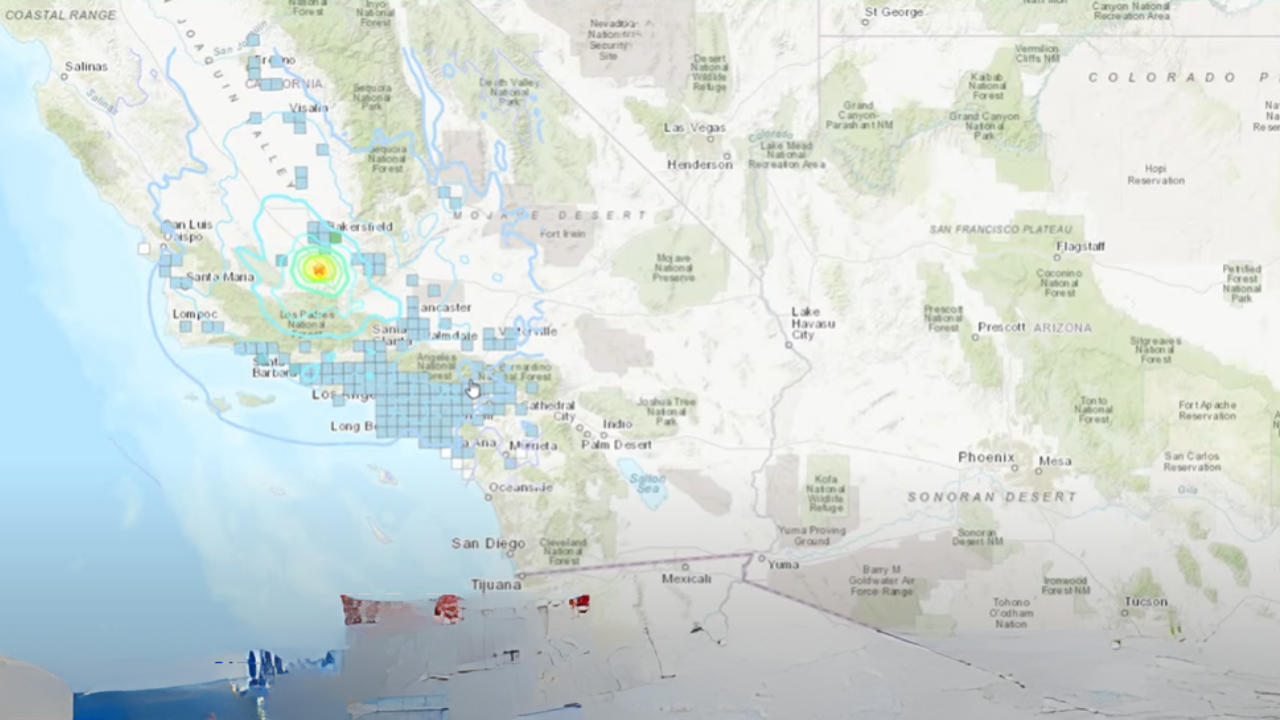An earthquake of magnitude 5.2 trembles across Southern California.

Southern California was rocked by a preliminary 5.2 magnitude earthquake that occurred Tuesday night close to Bakersfield.
The U.S. Geological Survey reports that the earthquake, which occurred at a depth of about 6 miles shortly after 9 p.m., was roughly 7.6 miles west northwest of Mettler in Kern County, about 19 miles south of Bakersfield, and 89 miles north of downtown Los Angeles.
People who reported feeling the tremor included individuals who lived in Ventura, Simi Valley, Camarillo, Santa Clarita, Encino, Hollywood, Santa Monica, North Hollywood, Pasadena, and Woodland Hills.
At least thirty-one aftershocks with a magnitude of 4.5 were recorded, according to the Seismological Laboratory at Caltech.
The Los Angeles Fire Department announced in a news release that “earthquake mode” was activated, causing all 106 neighborhood fire stations to survey the region by air, sea, and land.
“City teams will continue to monitor any impacts,” stated Los Angeles Mayor Karen Bass in a message on X, the previous Twitter platform, regarding the earthquake.
Additionally posting to X, L.A. Metro officials announced that trains would be operating slowly “per our earthquake procedure to check for any damage.”
Shortly after, transit officials issued an update stating that there was no system damage.
Distinguished seismologist Dr. Lucy Jones stated on X that the magnitude 5.2 earthquake was situated close to the White Wolf fault, which produced a magnitude 7.5 earthquake in 1952, in the southern end of the Central Valley, but that the earthquake did not seem to be on that fault.
According to Jones, “there’s a five percent chance that it will be followed by something bigger, like any earthquake in SoCal.”
An initial earthquake of 5.3 magnitude was followed by at least 22 aftershocks. The southern region of California
There were at least 22 aftershocks to the first 5.2-magnitude earthquake that was recorded in Southern California.
The first earthquake occurred at 9:09 p.m., according to the U.S. Geological Survey, and its preliminary magnitude was 5.2 (the early reports stated 5.7 before the USGS corrected the numbers). The center of the tremor was recorded at a depth of roughly 7.3 miles, and it occurred roughly 15.5 miles southwest of Lamont in Kern County, which is less than 90 miles from downtown Los Angeles.
Two aftershocks were recorded in Lamont shortly after the initial earthquake, and four more were recorded in the Grapevine region. Between 9:10 and 9:46 p.m., aftershocks were recorded, with preliminary magnitudes ranging from 2.5 to 4.5.
The city is in earthquake mode, according to the Los Angeles Fire Department, and crews are assessing the area for damage and local concerns.
Mayor Karen Bass of Los Angeles acknowledged the earthquake as well and said the city will keep an eye on potential effects.
Those who experienced the mild earthquakes are being asked by USGS to report on the organization’s website.
FOX 11 News offers an earthquake preparedness resource for those who need a refresher in case your neighborhood is struck by another earthquake soon.
An earthquake of magnitude 5.2 shakes Southern California, near Bakersfield.
Tuesday night, a large portion of Southern California felt the effects of a magnitude 5.2 earthquake that was located roughly 18 miles southwest of Bakersfield area.
The United States Geological Survey reports that the earthquake, which was first measured at magnitude 5.3, occurred at 9:09 p.m. At least twelve aftershocks of magnitude 2.5 and higher, including earthquakes with magnitudes of 4.5 and 4.1, were recorded after it.
The epicenter was located in a sparsely populated agricultural area, roughly 88 miles northwest of downtown Los Angeles, 60 miles northwest of Santa Clarita, and 14 miles northwest of the unincorporated city of Grapevine in Kern County.
Natural forces
The abrupt release of energy inside a small area of the Earth’s rocks is what causes earthquakes. Elastic strain, gravity, chemical reactions, and even the motion of large masses can all release energy. Since only one type of energy can be stored in large enough quantities on Earth to cause significant disruptions, the release of elastic strain is the most significant source of all of these. Tectonic earthquakes are defined as those connected to this kind of energy release.









